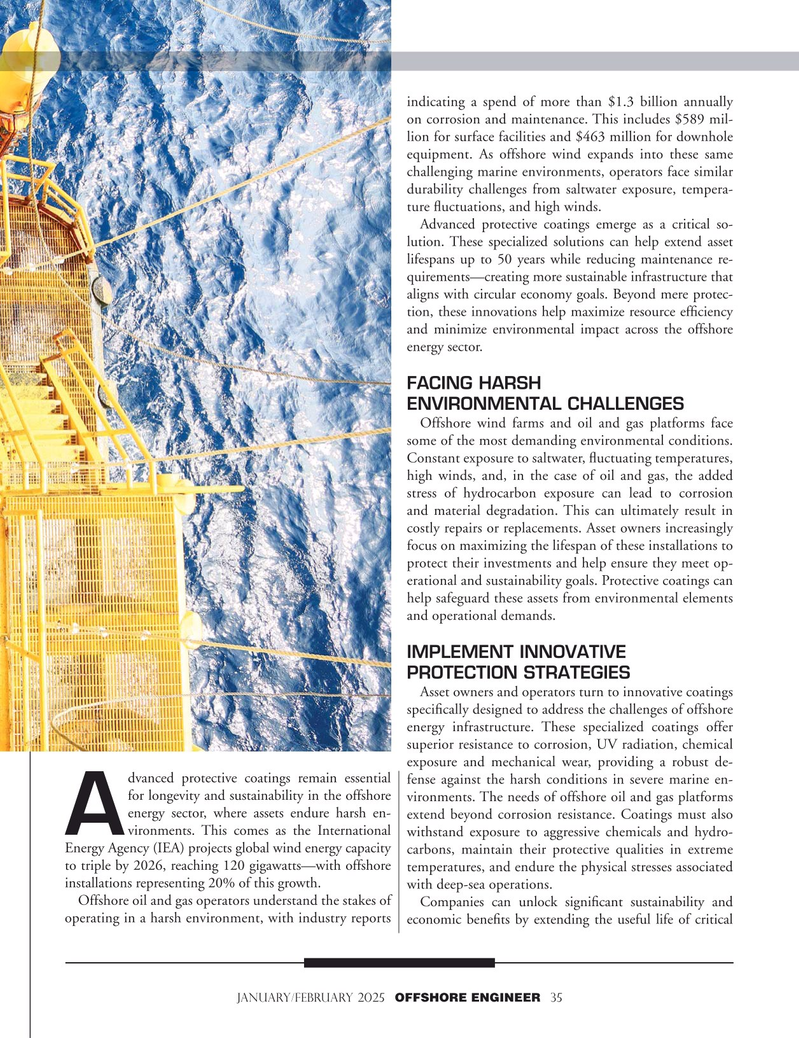
Page 35: of Offshore Engineer Magazine (Jan/Feb 2025)
Read this page in Pdf, Flash or Html5 edition of Jan/Feb 2025 Offshore Engineer Magazine
indicating a spend of more than $1.3 billion annually on corrosion and maintenance. This includes $589 mil- lion for surface facilities and $463 million for downhole equipment. As offshore wind expands into these same challenging marine environments, operators face similar durability challenges from saltwater exposure, tempera- ture ?uctuations, and high winds.
Advanced protective coatings emerge as a critical so- lution. These specialized solutions can help extend asset lifespans up to 50 years while reducing maintenance re- quirements—creating more sustainable infrastructure that aligns with circular economy goals. Beyond mere protec- tion, these innovations help maximize resource ef?ciency and minimize environmental impact across the offshore energy sector.
FACING HARSH
ENVIRONMENTAL CHALLENGES
Offshore wind farms and oil and gas platforms face some of the most demanding environmental conditions.
Constant exposure to saltwater, ?uctuating temperatures, high winds, and, in the case of oil and gas, the added stress of hydrocarbon exposure can lead to corrosion and material degradation. This can ultimately result in costly repairs or replacements. Asset owners increasingly focus on maximizing the lifespan of these installations to protect their investments and help ensure they meet op- erational and sustainability goals. Protective coatings can help safeguard these assets from environmental elements and operational demands.
IMPLEMENT INNOVATIVE
PROTECTION STRATEGIES
Asset owners and operators turn to innovative coatings speci?cally designed to address the challenges of offshore energy infrastructure. These specialized coatings offer superior resistance to corrosion, UV radiation, chemical exposure and mechanical wear, providing a robust de- dvanced protective coatings remain essential fense against the harsh conditions in severe marine en- for longevity and sustainability in the offshore vironments. The needs of offshore oil and gas platforms energy sector, where assets endure harsh en- extend beyond corrosion resistance. Coatings must also vironments. This comes as the International withstand exposure to aggressive chemicals and hydro-
A
Energy Agency (IEA) projects global wind energy capacity carbons, maintain their protective qualities in extreme to triple by 2026, reaching 120 gigawatts—with offshore temperatures, and endure the physical stresses associated installations representing 20% of this growth. with deep-sea operations.
Offshore oil and gas operators understand the stakes of Companies can unlock signi?cant sustainability and operating in a harsh environment, with industry reports economic bene?ts by extending the useful life of critical january/february 2025 OFFSHORE ENGINEER 35

 34
34

 36
36